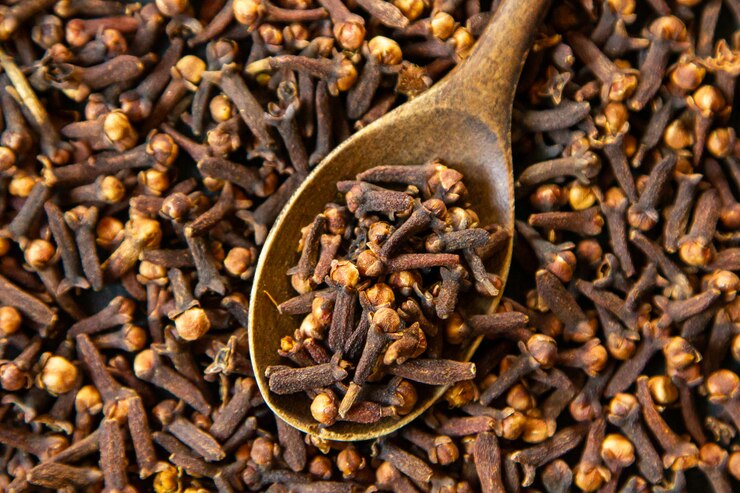Cloves have been a crucial element in foods and beverages for centuries. These are used in Asian, African, Mediterranean, and Middle Eastern countries. Their unique taste, aroma, and health benefits have made cloves a must-have spice in every kitchen. Cloves are native to Indonesia’s Maluku Islands, or Moluccas. Although Indonesia is the largest clove producer, it only exports 10-15% of the total production due to high domestic consumption.
Cloves are in high demand globally due to their extensive use in the food and beverage industry. Additionally, they are a key ingredient in various personal care and cosmetic products, such as toothpaste, perfumes, mouthwash, and more. India has emerged as a significant producer and exporter to meet the global demand for cloves.
This blog will explore India’s significance as a clove exporter and the top factors that drive global demand for Indian cloves.
Cloves Market: Past Trends vs. Future Growth Predictions
Between 2018 and 2022, the global cloves market grew steadily at an average annual rate of 4.5%. During this period, its value increased from $307.5 million to $366.7 million.
Looking ahead, the market is expected to continue growing at a similar pace. From $383.2 million in 2023, it is projected to reach $589.5 million by 2033, with an annual growth rate of 4.4%.
India’s Role in Clove Production and Export
Cloves were introduced to India by the East India Company around 1800 AD, with the first clove trees planted in Courtallam, Tamil Nadu. Since then, Tamil Nadu and its neighbouring states—Karnataka, Kerala, Andhra Pradesh, and Telangana—have become major producers of cloves.
Among these states, Tamil Nadu leads in clove production, with Kanyakumari earning the title of the “City of Cloves.” Together, Tamil Nadu and Kerala contribute over 90% of India’s total clove production.
In 2022, India exported cloves worth $14.4 million, making it the 8th largest clove exporter in the world. The top countries buying cloves from India were:
- United Arab Emirates (UAE) – $4 million
- United States (US) – $3.36 million
- Canada – $916,000
- Australia – $588,000
- Saudi Arabia – $412,000
These numbers show that Indian cloves are in high demand worldwide, especially in the Middle East, North America, and Australia.
Factors Driving the Global Demand for Indian Cloves
The demand for Indian cloves is increasing due to various reasons. Let’s take a closer look at them.
-
Rising Awareness of Natural Spices and Their Health Benefits
People are becoming more conscious of what they eat and are looking for natural, chemical-free ingredients. Cloves are known for their strong flavour and many health benefits.
They are rich in antioxidants, vitamins, and minerals, which help boost immunity, improve digestion, and reduce inflammation. As more people prefer natural remedies over artificial additives, the demand for Indian cloves is rising.
-
Increasing Use in Pharmaceuticals and Traditional Medicine
Cloves have been used in Ayurveda, Traditional Chinese Medicine, and Unani medicine for centuries. They are known for their antibacterial, antifungal, and pain-relieving properties.
Many pharmaceutical companies now use clove extracts in pain relief oils, cough syrups, and dental care products like toothpaste and mouthwash. The growing interest in herbal and alternative medicine has further boosted the demand for Indian cloves.
-
Expanding Culinary Applications Worldwide
Cloves are an essential ingredient in Indian, Middle Eastern, and Asian cuisines. They are used in spice blends like garam masala, added to curries, and even used in desserts and drinks.
In Western countries, cloves are popular in baked goods, mulled wine, and holiday recipes. As global food trends continue to embrace diverse flavours, more chefs and home cooks are including cloves into their dishes, increasing their demand.
-
Growth of the Organic and Sustainable Spice Market
Consumers today prefer organic and sustainably grown spices because they are free from pesticides and chemicals. India is focusing on organic clove farming, which makes its spices even more attractive in international markets.
Challenges in Meeting Global Demand
Despite the growing demand for Indian cloves, several challenges make it difficult to increase production and meet global needs. These challenges are:
-
Limited Genetic Variety
Clove trees in India have low genetic diversity, which affects their growth and resistance to diseases. Developing improved, high-yield varieties can help boost production.
-
Poor Farming Practices
Many farmers still use traditional methods that are not efficient. Better training and modern techniques can improve crop yield and quality.
-
Soil Fertility Issues
Clove trees need rich, well-managed soil, but poor soil fertility management reduces productivity. Using the right fertilizers and soil care techniques can help.
-
Pests and Diseases
Clove trees are affected by various pests and diseases, which reduce both quality and quantity. Stronger pest control measures and disease-resistant plants are needed.
-
Aging Plantations
Many clove plantations are old and less productive. Encouraging farmers to replant and rejuvenate these trees can improve yields.
-
Unorganised Markets and Price Fluctuations
The clove market in India is unorganised, leading to price instability. Creating a structured market with fair pricing can support farmers and traders.
-
Labour Shortages
Clove harvesting is labour-intensive, but there is often a shortage of workers during peak harvest seasons. Mechanised harvesting techniques or better labour management can help solve this issue.
The Bottom Line
Indian cloves have gained significant attention in the global market due to their rich aroma, medicinal benefits, and diverse culinary applications. The rising demand is driven by factors such as increasing awareness of natural spices, growing use in pharmaceuticals, expanding culinary trends, and the shift towards organic farming.
With the global spice market expanding steadily, Indian cloves have the potential to become a leading export product. By investing in research, high-yield crop varieties, and better infrastructure, India can strengthen its position as a key player in the global spice trade. The government’s support in terms of policy reforms, subsidies, and export promotions will also play a vital role in boosting production and profitability.


